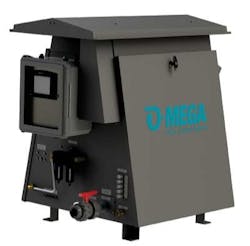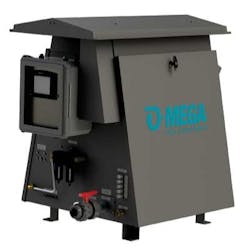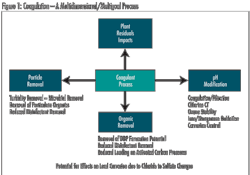Unearthing Efficient Mining Water Solutions
As environmental regulations become more stringent, South American mining companies are facing significant water challenges. Desalinated water is proving a vital source but with mines in Chile and Peru up to 200 kilometres from the coastline, water transport and networks are a major consideration, say Raymond Philippe and Hubert Fleming.
Infrastructure; P = Pipeline and Pumping System; E = Energy Supply
Mining investments in South America are very active. Nearly US$100 billion is expected to be spent during this decade in Chile and Peru alone. Other substantial investments will notably include Colombia, Brazil and other South American countries. This very large amount of projects will be executed in very challenging geographical settings, often high up in the Andes Mountains. It is the search for sustainable water sources to support both existing and new mineral processing needs that will prove even more challenging for these projects than electricity supply.
Arid regions such as the North of Chile or the South of Peru are facing an upcoming crisis in available land-based water resources, and are focusing on the use of seawater. However, even Mexico and Brazil are facing the same dilemma. The local mining industry is competing for the same resources as other users, putting at risk any long-term project development depending on the same stretched hydrological resources.
Conversely, and even in semi-arid regions, during part of the year mining operations may experience a surplus of water in their operations. Wet seasons or snow and ice melt may enter the mining operations: mine pits, tailings ponds, waste dumps and leach pads. As a result, some of this water may have to be discharged temporarily to the environment. And, as is the trend globally, South American environmental discharge legislation is becoming more stringent for mining companies. Peru and Chile, for example, have implemented some of the strictest environmental effluent discharge legislations worldwide, with some critical parameters required to meet standards even below potable water.
Geographic challenges
Both on the water supply side as well as the effluent discharge options, mining companies are facing continuation in demanding situations. In most cases, the use of seawater requires significant investments of marine structures, desalination plants, energy supply systems and moreover very complex water conveyance systems. In the mountainous regions of South America, notably Chile and Peru, many of the major mining projects being developed are located high up in the Andes mountains, at altitudes of up to 4 km above sea level and 200 kilometers from the coastline.
These mine water supply projects face several engineering and design challenges, as well as local political and economic challenges. These include local geography, community relations, environmental impacts, and energy requirements, for the implementation of large seawater treatment and conveyance systems. As such, there is a limit to alternative designs that can be considered for this type of coastal infrastructure projects. In order to achieve significant savings in investment and operational costs, the design of water supply projects must also involve the development of an accurate water balance. This is so that the seawater treatment plants, pipelines, and pumping stations, are not over (or under) designed. Project logistics must also reflect progressive change in the water demand and may need to consider a modular, expandable design.
Although the majority of the seawater supply projects are being identified as seawater desalination projects, in reality they are a result of a complex integration of marine works, a desalination treatment system combined with a high pressure conveyance pipeline and an energy transmission project. In practice, mining companies consider the project as a whole, and require a complete supply solution. This may result in a disconnect with the actual market because of the limited size of the desalination plant compared to the overall project.
Furthermore, it is not always logical that desalination OEM providers would manage the complete project, as they might in more conventional public sector desalination projects around the world.
Other important aspects to consider for design and construction in a mining environment, besides a required heavy duty design, are the very demanding quality, health and safety demands that the mining industry imposes. These must be reflected both in design as well as in project execution.
Consequences and costs are sometimes underestimated by process and equipment providers and construction companies, especially when their background experience is mostly in municipal potable and wastewater plants. The entire design, specification and procurement process is unique for the mining industry.
The high energy demand required for conveying the water, due to the great distances and elevations involved, and the availability of an energy supply source represent a significant challenge. Hence, a strong focus on optimisation is crucial to delivering a successful seawater treatment and conveyance project in northern Chile, for example. Previous design experience is fundamental in developing and delivering successful water supply projects, considering the large number of issues, various aspects and interactions encountered during design that must be taken into account.
Direct seawater Vs. desalinated water
Both Peru and Chile already have existing mining operations using desalinated seawater in their mineral processing plants. Several other major mining houses are in the definition or even implementation phases for similar treatment. Examples include Freeport McMoran, Anglo American, and Goldcorp among others. In order to meet their source water requirement , several are implementing the use of direct (salty) seawater as their make-up process water source - a recent example being AMSA's Esperanza mine.
The use of direct seawater versus desalinated water is generally a trade off between capital and operating costs. That operating cost must include the impact of seawater on operations of the mine as well, including effect on metallurgy of mine equipment, as well as efficiency of the mining or beneficiation or ore recovery processing plant. There is often a substantial difference in benefits associated with comparing parameters as metallurgical recovery and even effective production time due to plant availability between seawater and desalinated water.
Direct cost for desalinated seawater supply, depending on altitude and distance from the coast, and price of energy, will vary between US$1 to US$4 per cubic meter. This cost is evaluated against the benefits of water to mine production. In the case of the copper mining industry, desalinated seawater supply cost may represent between 3% to 20% of total direct operational costs. It's clear to see how water becomes one of the most impacting consumables for the mining industry. In addition, with lower quality metal contents in available mineral resources, a net higher water consumption per pound of metal produced is required, further driving up water costs as a percent of total cost of operations.
Water usage and recycling
As a consequence, the mining industry located in arid regions of South America is looking at strategies to improve water usage, especially focusing on better water recycling rates. Processes are being optimised to improve water return from tailing ponds, to avoid water losses due to evaporation and infiltration, and to avoid generation of effluents. As an example, in a concentrator mill with a conventional tailing storage facility, total water retention may be up to 50% compared to newer developments such as thickened tailings or paste technology.
There are risks associated with water usage optimisation that must be evaluated, which are not always understood or even considered when aiming at low make-up water supply for mining operations. These risks can only be quantified through an analysis of both the quantitative water balance as well as a qualitative water balance.
Mineral processing sites may use various feed water qualities, to which reagents are being added to the process streams, and may even suffer from geochemical processes like acid mine drainage generation. As a result, generally there is imbalance between the water quantity and quality distributions.
One of the major disadvantages of recirculating and recycling water is the possible build-up of contaminants in the water balance. If less fresh water is used and instead more contaminated water is being reused, there will be a higher risk of contaminant retention in the system that may have various negative chemical effects, such as corrosion, scale formation, modification of metallurgical chemistry and so forth. As a result the mine site may start suffering economical consequences due to less plant availability, higher maintenance requirements or even less metallurgical recovery and production.
Although huge savings may be obtained in water supply requirements, this has to be offset against possible bleed stream requirements due to a build-up of contaminants in the process water circuit to avoid these downsides. This may especially be the case in mineral processing systems that consider the use of poor quality water such as direct seawater or brackish well water.
New technologies
Although there are less traditional land-based viable water supplies available, future mining projects in South America seem to have found a new source that may quench its thirst: the ocean. New technology developments and best practices applied to water management in the mining industry may help ease the economical impact of supplying (desalinated) seawater to the mine sites. In order to resolve the negative effects of contaminants build up due to high efficient water usage, the next steps for improvement of mineral processing economics will have to include the integration of water quality and chemistry within the mine site water management plans.
Going forward, effective water management in the industry will include desalination, as well as more effective wastewater treatment and reuse. WWi
Author's note:Raymond Philippe is the Chile water director and Hubert Fleming, Ph.D., is the global director water at Hatch. For more information, please email: [email protected].
More Water & WasteWater International Current Issue Articles
More Water & WasteWater International Archives Issue Articles



